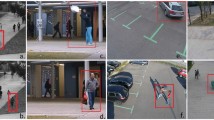Abstract
Design and implementation of an effective surveillance system is a challenging task. In practice, a large number of CCTV cameras are installed to prevent illegal and unacceptable activities where a human operator observes different camera views and identifies various alarming cases. But reliance on the human operator for real-time response can be expensive as he may be unable to pay full attention to all camera views at the same time. Moreover, the complexity of a situation may not be easily perceivable by the operator for which he might require additional support in response to an adverse situation. In this paper, we present a Decision Support Engine (DSE) to select and schedule most appropriate camera views that can help the operator to take an informed decision. For this purpose, we devise a utility based approach where the utility value changes based on automatically detected events in different surveillance zones, event co-relation, and operator’s feedback. In addition to the selected camera views, we propose to synthetically embed extra information around the camera views such as event summary and suggested action plan to globally perceive the current situation. The experimental results show the usefulness of the proposed decision support system.







Similar content being viewed by others
References
Ahmed DT, Shirmohammadi S (2011) A decision support engine for video surveillance systems. In: Proc. IEEE workshop on advances in automated multimedia surveillance for public safety, In: Proc. IEEE international conference on multimedia & Expo, pp 1–6
Atrey PK, Kankanhalli M, Jain R (2006) Information assimilation framework for event detection in multimedia surveillance systems. In: Special issue on multimedia surveillance systems in springer/acm multimedia systems journal, pp 239–253
Atrey PK, El Saddik A, KankanhalliM(2011) Effective multimedia surveillance using a humancentric approach. Multimedia Tools and Applications 51:697–721
Baumann M, MacLean K, Hazelton T, McKay A (2010) Emulating human attention getting practices with wearable haptics. In: IEEE haptics symposium, pp 149–156
Davis M (2003) Active capture: integrating human-computer interaction and computer vision/audition to automate media capture. In: Proc. IEEE international conference on multimedia & expo, vol 2, pp 185–188
Hossain MA, Atrey PK, El Saddik A (2011) Modeling and assessing quality of information in multisensor multimedia monitoring systems. ACM Trans Multimedia Comput Commun Appl 7(3):1–3:30
Ivanov Y, Bobick A (2000) Recognition of visual activities and interactions by stochastic parsing. IEEE Trans Pattern Anal Mach Intell 22:852–872
Leykin A, Hammoud R (2008) Real-time estimation of human attention field in lwir and color surveillance videos. In: IEEE international workshop on object tracking and classification in and beyond the visible spectrum, pp 1–6
Liu A, Zhang Y, Song Y, Zhang D, Li J, Yang Z (2008) Human attention model for semantic scene analysis in movies. In: Proc. IEEE international conference on multimedia & expo, pp 1473–1476
Ma YF, Lu L, Zhang HJ, Li M (2003) A user attention model for video summarization. In: ACM international conference on multimedia, p 533542
Nguyen N, Bui H, Venkatesh S, West G (2003) Recognising and monitoring high-level behaviours in complex spatial environments. IEEE Comput Soc Conf Comput Vis Pattern Recogn 2:620
Norris C, Armstrong G (1999) The maximum surveillance society: the rise of CCTV. Berg Publishers
Oates T, Schmill M, Cohen P (2000) A method for clustering the experiences of a mobile robot that accords with human judgments. In: Proceedings of IJCAI, pp 846–851
Peters C (2003) Attention-driven eye gaze and blinking for virtual humans
Rath T, Manmatha R (2003) Features for word spotting in historical manuscripts. In: International conference on document analysis and recognition, vol 1, p 218
Smith GJ (2004) Behind the screens: Examining constructions of deviance and informal practices among cctv control room operators in the UK. Surveillance & Society, CCTV Special (eds. Norris, McCahill and Wood) 2(3):376–395
Vaiapury K, Kankanhalli MS (2008) Finding interesting images in albums using attention. J Multimed 3:1–12
Wallace E, Diffey C (1998) CCTV control room ergonomics. Tech. rep., police scientific development branch, UK home office
Acknowledgements
This research is supported by NPST program by King Saud University Project Number 11-INF1830-02.
Author information
Authors and Affiliations
Corresponding author
Rights and permissions
About this article
Cite this article
Ahmed, D.T., Hossain, M.A., Shirmohammadi, S. et al. Utility based decision support engine for camera view selection in multimedia surveillance systems. Multimed Tools Appl 73, 219–240 (2014). https://doi.org/10.1007/s11042-012-1294-7
Published:
Issue Date:
DOI: https://doi.org/10.1007/s11042-012-1294-7




